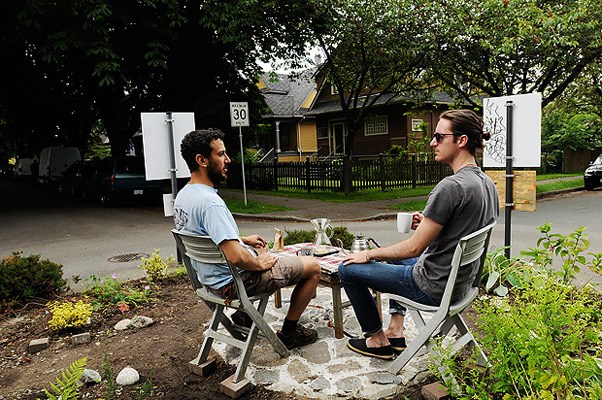It's a crisp Sunday morning — one of those rare, bone-dry, sunny winter days — and Julien Thomas has a satisfied look about him. Sitting on a kitchen chair that's seen better days in the middle of a traffic circle at the intersection of St. George Street and the 10th Avenue bike route with a fresh pot of coffee at his feet, the 26-year-old Mount Pleasant resident holds court. A shawl-wearing cyclist breezes past and rings her bell. Cars slow down and drivers nod in approval. A three-year-old chocolate lab named Hobbs stops by with his owner to investigate the rosemary, lavender, mint, sunflowers and ferns planted during the warmer months. Neighbours wave. A musician lugs his stand-up bass down the street to get it repaired. A bearded man on a customized, yarn-bombed "tall bike" teeters towards us and asks Thomas about his breakfast plans.
A year ago, this traffic circle was like hundreds of others around Â鶹´«Ã½Ó³»â€” taken for granted, strictly utilitarian and, as Thomas saw it, a blank slate open to interpretation.
A lifetime resident of Â鶹´«Ã½Ó³»who works in construction, Thomas first became involved in the neighbourhood through efforts to "daylight" sections of a creek running beneath St. George Street. That got him thinking about different ways in which residents could reclaim and transform their streets, which, in turn, led him to ponder the many wonders of traffic calming circles — not only as a means of creating urban green spaces through the city's Green Streets Program, but nurturing hubs of community activity and interaction.
"For me, the original goal was to find some sort of connection to a city that I grew up in, in which we don't really talk about why we belong here or how we belong here," he says.
Last spring, Thomas applied to the Â鶹´«Ã½Ó³»Foundation's Neighbourhood small grants fund and received $800. The money went towards plants, some of which were also donated by neighbours, a stonework mosaic created by artist Krista Morrison, a website and a Chemex glass pour-over coffeemaker to keep visitors and weekend work parties caffeinated.
The result is , a three-square-metre patch of tranquility and neighbourly goodwill, which Thomas likes to think of as "Vancouver's smallest park," though it doesn't have official park designation.
It's the site of weekend work parties and friendly gatherings throughout the spring and summer, and in September, he heard that a group of people had dressed up in costumes and held a Mad Hatter Tea Party in the circle one night. Even brewing the coffee has become a community effort with nearby Matchstick Coffee donating the beans while a neighbour lets Thomas access his water and electricity for his guerrilla barista activities.
A few houses down the tree-lined street of heritage homes, some more pristine than others, and the occasional Â鶹´«Ã½Ó³»Special, 24-year-old George Rahi, the bearded owner of the ridiculously tall, sweater-wearing bicycle, shows me his book collection.
Last spring, he and his roommates set up a makeshift "lending library" in front of their house, fashioned out of a salvaged shelf, where passersby are encouraged to leave or take a book from the dozens on offer.
What started as a smattering of free reading material has blossomed into an announcement board, an impromptu meeting place and stacks of magazines and books ranging from Harry Potter and Harlequin romances to obscure Russian novels and cookbooks. While he rents a suite in the house, Rahi says his landlord has been supportive or, at the very least, tolerant.
"I think it's valuable to see the places where you live in terms of something that's worth putting in an effort to build more connections," Rahi says, "because it's pretty easy to be a mobile renter who's floating around the city and doesn't really know their neighbours."
Rahi, who's originally from Pennsylvania and currently completing a master's degree in geography at UBC, admits to being surprised by the enthusiastic response his library has received. He particularly appreciates how something as innocuous as an outdoor bookshelf or traffic circle can inspire neighbours to get to know one another. "I love that it's an unexpected reclaiming of a public space that people don't think twice about, but draws people in and makes people think differently of how little space we need to actually make something interesting happen."
Back at the traffic circle, Thomas pours another cup of coffee. "Oh yeah... this is flowing nicely," he says, adding that he recently bought a stainless steel filter, which he's been gradually "dialing in."
Although he's had to navigate his way through typical hoops and red tape from the city — no permanent structures such as tarps, kiosks or chairs, for instance — Thomas says Gather Round is a constantly evolving project and "just the tip of the iceberg" of what can be done when a neighbourhood comes together.
"Creating novel or unique spaces allows people to step out of their daily routine and have a different conversation," he says. "We walk around the city with a shell on sometimes, and when you step into a traffic circle the shell kind of breaks away and you can talk about what you want."
Then there are those who are able to talk about what they want just by slowing down and unrolling the window of their beat-up Ford Escort, as was the case with a jovial man who resembled a longtime resident of Margaritaville. "Hey," he said with a hazy smile familiar to most people in this city, before driving away. "You guys should grow some weed in there."
Apparently you can take the traffic circle out of Â鶹´«Ã½Ó³»but you can't take the Â鶹´«Ã½Ó³»out of the traffic circle.
twitter.com/MidlifeMan1



